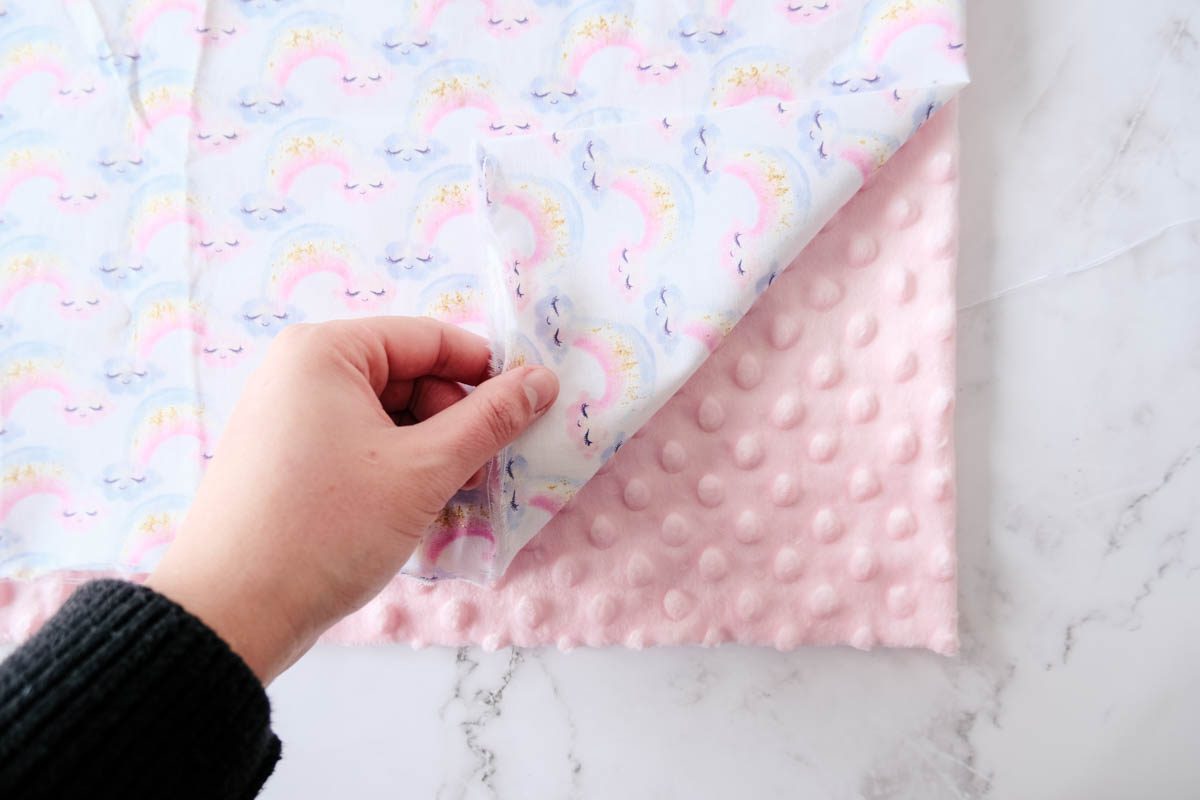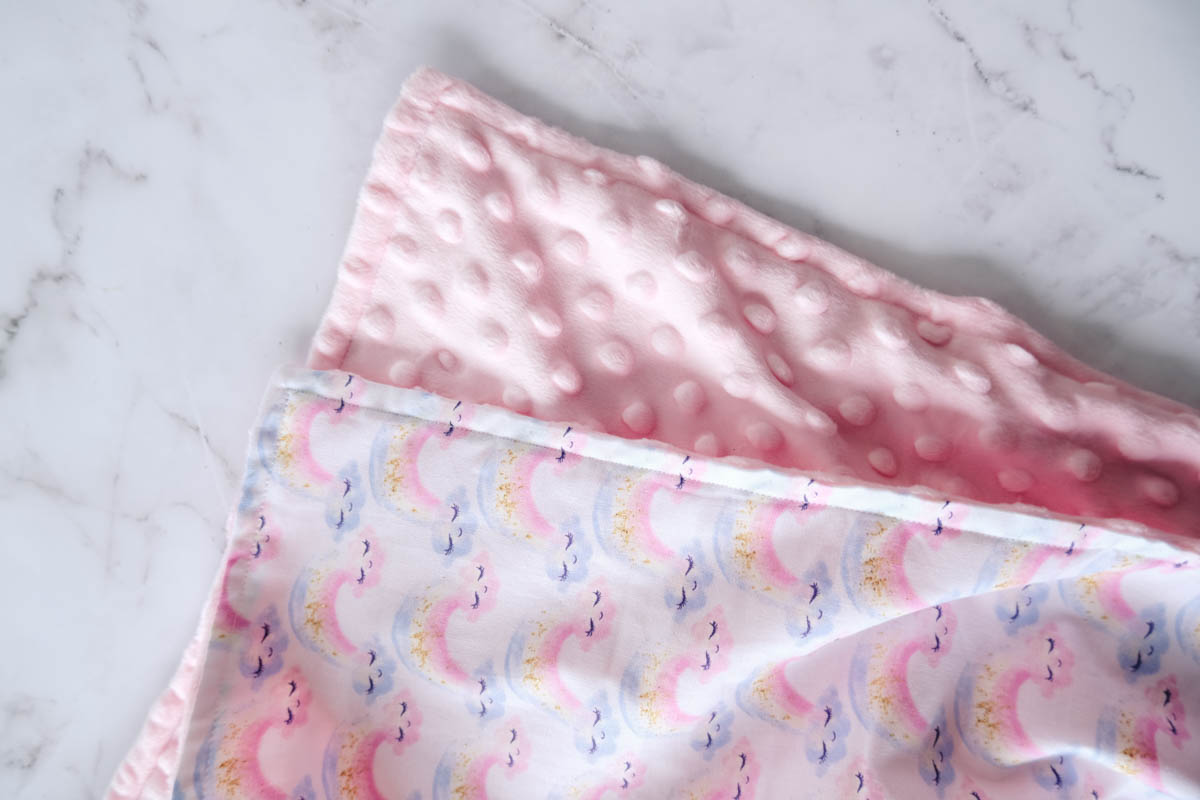Looking to add a personal touch to your baby’s nursery or make a heartfelt gift for a special someone? Our easy-to-follow sewing guide will teach you how to create a charming and cosy diy baby blanket. With just a few materials and basic sewing skills, you’ll have a plush and snuggly blanket that will keep your little one warm and content.

As an Amazon Associate, I earn from qualifying purchases. Read my full disclosure here.
Why You Will Love This Baby Blanket
- Soft and Gentle – the mink fabric used in this baby blanket is incredibly soft and gentle against your baby’s delicate skin, providing a cosy and comfortable experience. If you prefer natural materials, I have included a list of alternatives below.
- Durable and Long-Lasting – the combination of mink fabric and cotton backing ensures that this blanket is built to withstand the test of time, making it a durable and long-lasting item in your baby’s nursery.
- Customisable – by choosing your preferred colours, and patterns, and even adding personal touches such as embroidery, you can create a unique and personalised baby blanket that reflects your style and love. This touch can make for a special gift!
- Practical – this baby blanket is perfect for keeping your little one warm and snug. It can also be used as a play mat, tummy time blanket, or even a nursing cover, making it a versatile and practical addition to your baby’s essentials.
If you are new to sewing checkout these helpful sewing articles:
Natural Baby Blanket Fabric Suggestions
If you would prefer natural fabric options here are 3 fabric suggestions that prioritise natural, non-toxic options suitable for a baby blanket.
In my article about sustainable fabric types, you can learn everything you need to know about the different fabrics available and why they are a great choice.
1. Soft and Organic Pair
Organic Bamboo Velour Fabric – organic bamboo velour fabric is incredibly soft, hypoallergenic, and gentle on your baby’s skin. It offers a luxurious feel and is an excellent choice for a natural alternative to mink fabric.
Organic Cotton Muslin Fabric – pair the organic bamboo velour fabric with organic cotton muslin for the topping layer. Organic cotton muslin is lightweight, breathable, and perfect for warm weather. It is also known for its durability and softness.
2. Natural and Cosy Pair:
Organic Cotton Fleece Fabric – organic cotton fleece fabric is a cosy and natural alternative to mink fabric. It is soft, warm, and made from 100% organic cotton, ensuring it is free from harmful chemicals and safe for your baby.
Organic Cotton Interlock Knit Fabric – pair the organic cotton fleece fabric with organic cotton interlock knit fabric for the topping layer. Organic cotton interlock knit is stretchy, and comfortable, and provides a smooth surface for your baby to snuggle against.
3. Gentle and Eco-Friendly Pair:
Organic Cotton Sherpa Fabric – organic cotton Sherpa fabric is a gentle and eco-friendly alternative to mink fabric. It is soft, fluffy, and made from 100% organic cotton, providing a cosy blanket for your baby.
Organic Cotton Flannel Fabric – pair the organic cotton sherpa fabric with organic cotton flannel for the topping layer. Organic cotton flannel is warm, soft, and available in various adorable prints. It adds an extra layer of comfort to the blanket.
These fabric pairs prioritise natural, non-toxic materials that can be safer for your baby’s sensitive skin while still providing softness, comfort, and warmth.
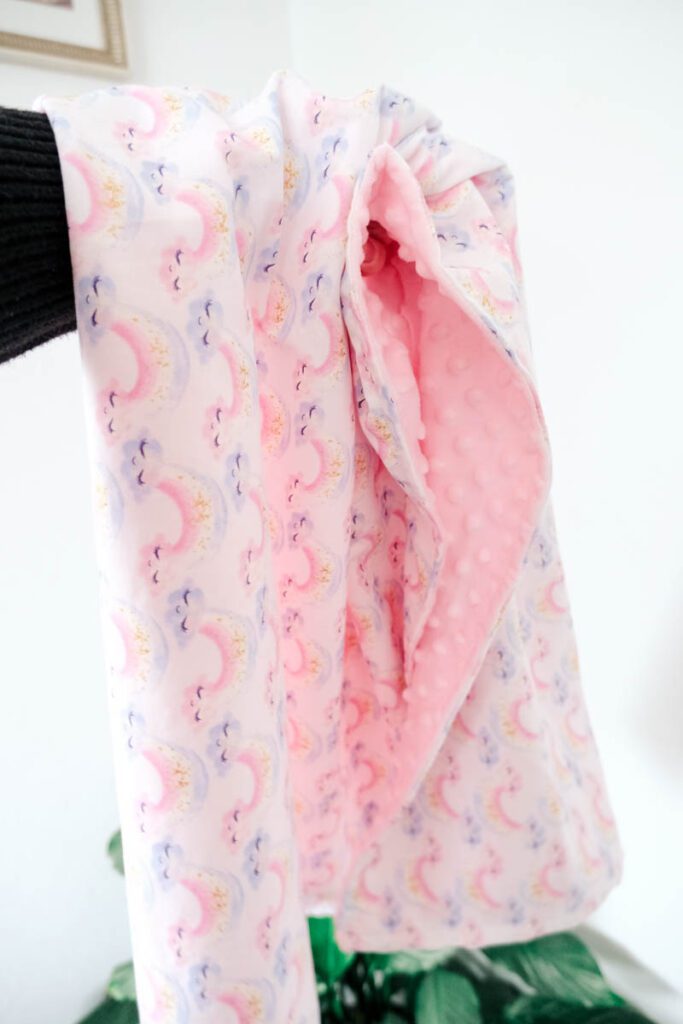
Materials You Will Need
- 1 meter (1 yard) mink fabric – Mink fabric is a plush, soft fabric that is perfect for baby blankets.
- 1 meter (1 yard) cotton fabric – The cotton fabric will be used for the backing of the blanket, providing additional comfort and durability.
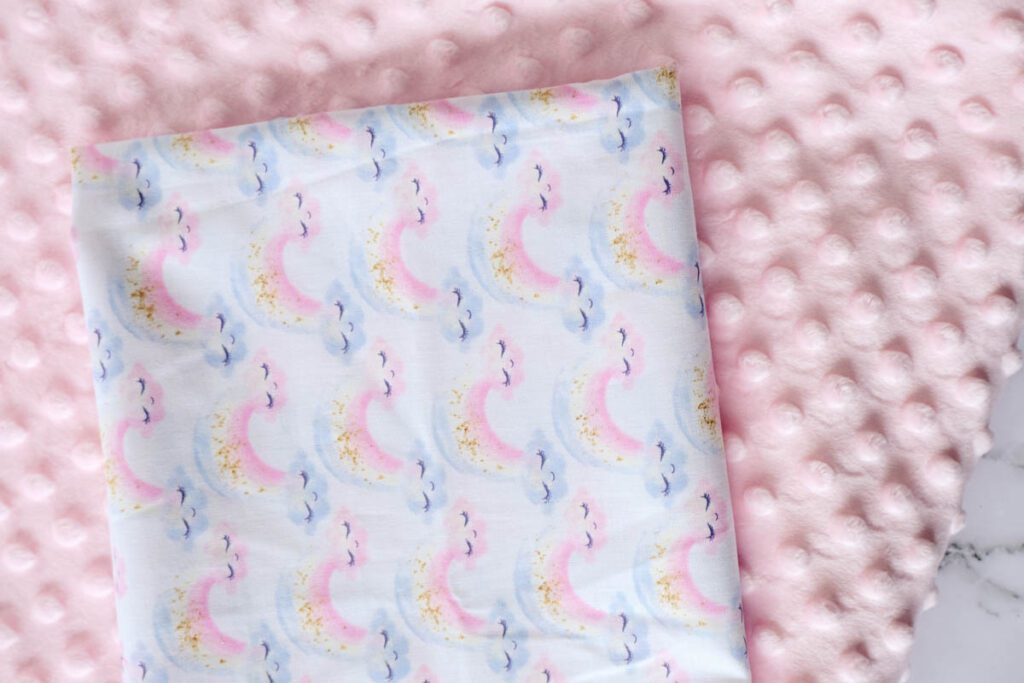
Tools You Will Need
How to Sew a Baby Blanket – Step-by-Step Instructions
Step 1: Preparing the Fabric
Start by washing and ironing your fabric to remove any wrinkles. This step is particularly important if you’re using fabric that hasn’t been pre-washed.
Step 2: Cutting the Fabric
Measure and cut both the mink fabric and cotton fabric to your desired blanket size. The size I have used for my baby blanket is approximately 1 meter by 1 meter (1 yard x 1 yard), but you can adjust the dimensions according to your preference.

Step 3: Placing the Fabrics Right Sides Together
Lay the mink and cotton fabric on each other, with the right sides together. Align the edges and secure them with pins or clips, leaving a small opening for turning the blanket right side out later.
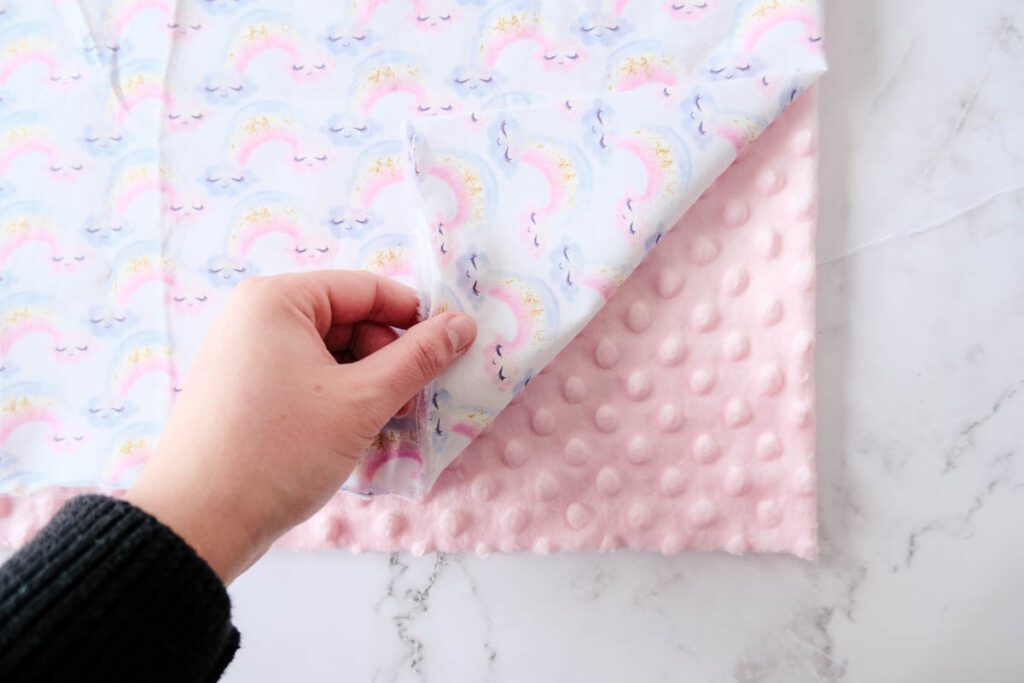
Step 4: Sewing the Blanket
Using a sewing machine or needle and thread, sew along the edges of the fabrics, leaving a 1cm (1/2”) seam allowance. Start sewing a few centimetres away from the opening and remember to backstitch at the beginning and end to secure the stitches. Continue sewing until you reach the next side, leaving a 5cm (2”) opening space.

Step 5: Turning the Blanket Right Side Out
Trim the corners of the blanket then carefully turn the blanket right side out through the opening. Use a blunt tool, such as a knitting needle or the closed tip of a pair of scissors, to push out the corners and create clean edges.

Step 6: Closing the Opening
Fold the raw edges of the opening inward and press them with an iron. Pin the opening closed, ensuring the edges are aligned. Topstitch along the entire edge of the blanket, making sure to stitch over the opening to secure it.

Step 7: Adding Finishing Touches (Optional)
If desired, you can add decorative touches to your baby blanket. For example, you could sew a border around the edges using a chain stitch or add personalised embroidery with the baby’s name or initials using a backstitch.
And there you have it—a beautiful DIY baby blanket that is soft, cosy, and made with love! This project is a wonderful way to create a special keepsake for your little one or to give as a thoughtful gift to someone special.
Tips and Tricks
- When sewing with fabrics like mink, bamboo velour, or fleece, it’s recommended to use a ballpoint or stretch needle. These needles will help prevent skipped stitches and fabric damage.
- Opt for a polyester thread, as it is strong, durable, and suitable for most fabric types. Learn more about thread types in my sewing thread types article.
- You can use fabric clips instead of pins, especially if you find pins difficult to insert into the fabric.
Frequently Asked Questions
Is it necessary to pre-wash the fabrics before sewing?
It is highly recommended to pre-wash both the mink fabric and cotton fabric before starting the sewing process. This will prevent any potential shrinkage or colour bleeding that may occur when the blanket is washed after completion.
How can I add extra warmth to the blanket?
If you wish to make the blanket warmer, consider adding a batting or fleece layer between the mink fabric and cotton backing. This will provide an additional layer and create a thicker blanket. You can try sewing a running stitch to create a scrumptious quilt.
How do I care for the baby blanket once it’s completed?
To maintain the softness and quality of the baby blanket, it is recommended to machine wash it on a gentle cycle using mild detergent. Avoid using harsh chemicals or bleach. Tumble dry on low heat or air dry to prevent any damage or shrinkage.
DIY Baby Blanket Conclusion
In conclusion, sewing a DIY baby blanket using the provided tutorial and fabric alternatives is a fulfilling and meaningful project that allows you to create a soft, safe, and non-toxic blanket for your little one or as a heartfelt gift.
With its simplicity and versatility, this beginner-friendly sewing project lets you showcase your creativity while providing comfort and warmth. Follow the tips and guidance shared throughout the tutorial to achieve professional-looking results and remember to embrace the joy of crafting something with love and care. Happy sewing!
More Beginner Sewing Projects to Try:
DIY Baby Blanket Step-by-Step Sewing Tutorial

Looking to add a personal touch to your baby's nursery or make a heartfelt gift for a special someone? Our easy-to-follow sewing guide will teach you how to create a charming and cosy do-it-yourself baby blanket. With just a few materials and basic sewing skills, you'll have a plush and snuggly blanket that will keep your little one warm and content.
Materials
- 1 meter (1 yard) mink fabric - Mink fabric is a plush, soft fabric that is perfect for baby blankets.
- 1 meter (1 yard) cotton fabric - The cotton fabric will be used for the backing of the blanket, providing additional comfort and durability.
Tools
- Sewing machine
- Ballpoint sewing machine needle
- Thread
- Fabric scissors
- Pins
- Iron
Instructions
- Step 1: Prepare the Fabric
Start by washing and ironing your fabric to remove any wrinkles. This step is particularly important if you're using fabric that hasn't been pre-washed. - Step 2: Cutting the Fabric
Measure and cut both the mink fabric and cotton fabric to your desired blanket size. The size I have used for my baby blanket is approximately 1 meter by 1 meter (1 yard x 1 yard), but you can adjust the dimensions according to your preference. - Step 3: Placing the Fabrics Right Sides Together
Lay the mink and cotton fabric on each other, with the right sides together. Align the edges and secure them with pins or clips, leaving a small opening for turning the blanket right side out later. - Step 4: Sewing the Blanket
Using a sewing machine or needle and thread, sew along the edges of the fabrics, leaving a 1cm (1/2”) seam allowance. Start sewing a few centimetres away from the opening and remember to backstitch at the beginning and end to secure the stitches. Continue sewing until you reach the next side, leaving a 5cm (2”) opening space. - Step 5: Turning the Blanket Right Side Out
Trim the corners of the blanket then carefully turn the blanket right side out through the opening. Use a blunt tool, such as a knitting needle or the closed tip of a pair of scissors, to push out the corners and create clean edges. - Step 6: Closing the Opening
Fold the raw edges of the opening inward and press them with an iron. Pin the opening closed, ensuring the edges are aligned. Topstitch along the entire edge of the blanket, making sure to stitch over the opening to secure it. - Step 7: Adding Finishing Touches (Optional)
If desired, you can add decorative touches to your baby blanket. For example, you could sew a border around the edges using a chain stitch or add personalised embroidery with the baby's name or initials using a backstitch.
And there you have it—a beautiful DIY baby blanket that is soft, cosy, and made with love! This project is a beautiful way to create a special keepsake for your little one or to give as a thoughtful gift to someone
Notes
Sewing Tips:
- When sewing with fabrics like mink, bamboo velour, or fleece, it's recommended to use a ballpoint or stretch needle. These needles will help prevent skipped stitches and fabric damage.
- Opt for a polyester thread, as it is strong, durable, and suitable for most fabric types. Learn more about thread types in my sewing thread types article.
- You can use fabric clips instead of pins, especially if you find pins difficult to insert into the fabric.
Is it necessary to pre-wash the fabrics before sewing?
It is highly recommended to pre-wash both the mink fabric and cotton fabric before starting the sewing process. This will prevent any potential shrinkage or colour bleeding that may occur when the blanket is washed after completion.
How can I add extra warmth to the blanket?
If you wish to make the blanket warmer, consider adding a batting or fleece layer between the mink fabric and cotton backing. This will provide an additional layer and create a thicker blanket. You can try sewing a running stitch to create a scrumptious quilt.
How do I care for the baby blanket once it's completed?
To maintain the softness and quality of the baby blanket, it is recommended to machine wash it on a gentle cycle using mild detergent. Avoid using harsh chemicals or bleach. Tumble dry on low heat or air dry to prevent any damage or shrinkage.

